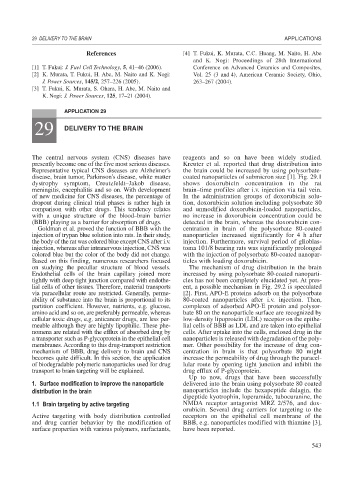Page 571 - Book Hosokawa Nanoparticle Technology Handbook
P. 571
29 DELIVERY TO THE BRAIN APPLICATIONS
References [4] T. Fukui, K. Murata, C.C. Huang, M. Naito, H. Abe
and K. Nogi: Proceedings of 28th International
[1] T. Fukui: J. Fuel Cell Technology, 5, 41–46 (2006). Conference on Advanced Ceramics and Composites,
[2] K. Murata, T. Fukui, H. Abe, M. Naito and K. Nogi: Vol. 25 (3 and 4), American Ceramic Society, Ohio,
J. Power Sources, 145/2, 257–226 (2005). 263–267 (2004).
[3] T. Fukui, K. Murata, S. Ohara, H. Abe, M. Naito and
K. Nogi: J. Power Sources, 125, 17–21 (2004).
APPLICATION 29
29 DELIVERY TO THE BRAIN
The central nervous system (CNS) diseases have reagents and so on have been widely studied.
presently become one of the five most serious diseases. Kreuter et al. reported that drug distribution into
Representative typical CNS diseases are Alzheimer’s the brain could be increased by using polysorbate-
disease, brain tumor, Parkinson’s disease, white matter coated nanoparticles of submicron size [1]. Fig. 29.1
dystrophy symptom, Creutzfeldt–Jakob disease, shows doxorubicin concentration in the rat
meningitis, encephalitis and so on. With development brain–time profiles after i.v. injection via tail vein.
of new medicine for CNS diseases, the percentage of In the administration groups of doxorubicin solu-
dropout during clinical trial phases is rather high in tion, doxorubicin solution including polysorbate 80
comparison with other drugs. This tendency relates and unmodified doxorubicin-loaded nanoparticles,
with a unique structure of the blood–brain barrier no increase in doxorubicin concentration could be
(BBB) playing as a barrier for absorption of drugs. detected in the brain, whereas the doxorubicin con-
Goldman et al. proved the function of BBB with the centration in brain of the polysorbate 80-coated
injection of trypan blue solution into rats. In their study, nanoparticles increased significantly for 4 h after
the body of the rat was colored blue except CNS after i.v. injection. Furthermore, survival period of glioblas-
injection, whereas after intranervous injection, CNS was toma 101/8 bearing rats was significantly prolonged
colored blue but the color of the body did not change. with the injection of polysorbate 80-coated nanopar-
Based on this finding, numerous researchers focused ticles with loading doxorubicin.
on studying the peculiar structure of blood vessels. The mechanism of drug distribution in the brain
Endothelial cells of the brain capillary joined more increased by using polysorbate 80-coated nanoparti-
tightly with deep tight junction compared with endothe- cles has not been completely elucidated yet. At pres-
lial cells of other tissues. Therefore, material transports ent, a possible mechanism in Fig. 29.2 is speculated
via paracellular route are restricted. Generally, perme- [2]. First, APO-E proteins adsorb on the polysorbate
ability of substance into the brain is proportional to its 80-coated nanoparticles after i.v. injection. Then,
partition coefficient. However, nutrients, e.g. glucose, complexes of adsorbed APO-E protein and polysor-
amino acid and so on, are preferably permeable, whereas bate 80 on the nanoparticle surface are recognized by
cellular toxic drugs, e.g. anticancer drugs, are less per- low-density lipoprotein (LDL) receptor on the epithe-
meable although they are highly lipophilic. These phe- lial cells of BBB as LDL and are taken into epithelial
nomena are related with the efflux of absorbed drug by cells. After uptake into the cells, enclosed drug in the
a transporter such as P-glycoprotein in the epithelial cell nanoparticles is released with degradation of the poly-
membranes. According to this drug-transport restriction mer. Other possibility for the increase of drug con-
mechanism of BBB, drug delivery to brain and CNS centration in brain is that polysorbate 80 might
becomes quite difficult. In this section, the application increase the permeability of drug through the paracel-
of biodegradable polymeric nanoparticles used for drug lular route by opening tight junction and inhibit the
transport to brain targeting will be explained. drug efflux of P-glycoprotein.
Up to now, drugs that have been successfully
1. Surface modification to improve the nanoparticle delivered into the brain using polysorbate 80 coated
distribution in the brain nanoparticles include the hexapeptide dalagin, the
dipeptide kyotrophin, loperamide, tubocuranine, the
1.1 Brain targeting by active targeting NMDA receptor antagonist MRZ 2/576, and dox-
orubicin. Several drug carriers for targeting to the
Active targeting with body distribution controlled receptors on the epithelial cell membrane of the
and drug carrier behavior by the modification of BBB, e.g. nanoparticles modified with thiamine [3],
surface properties with various polymers, surfactants, have been reported.
543

